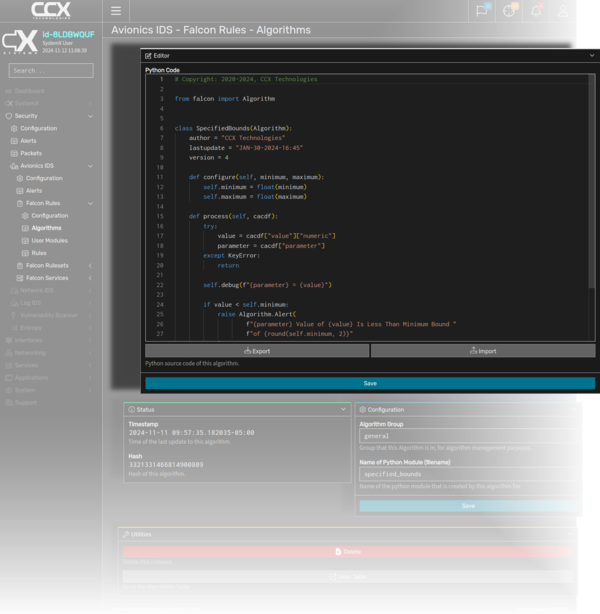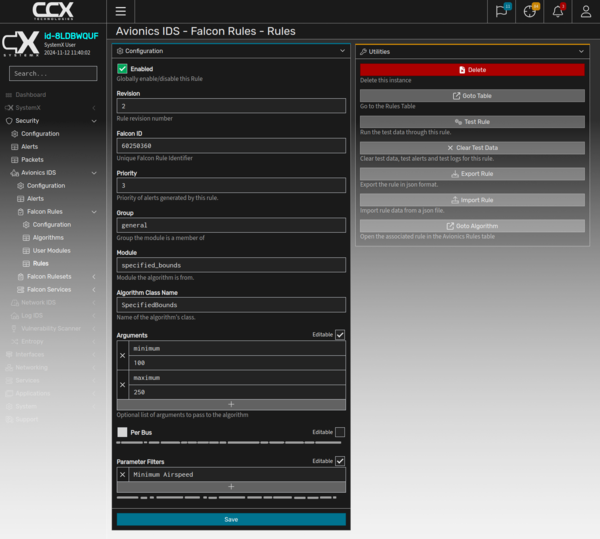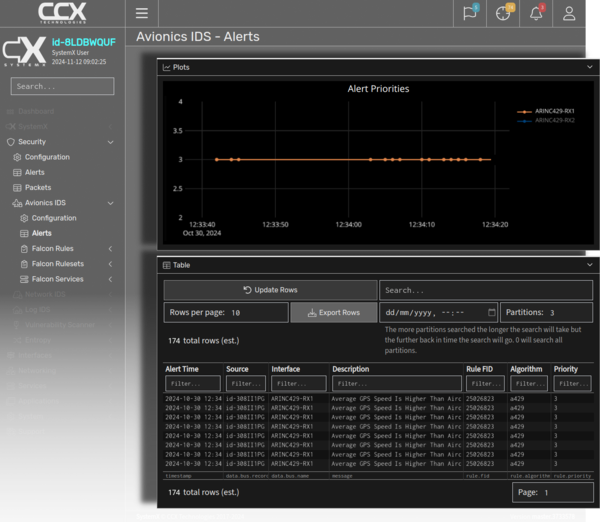CCX Technologies Falcon IDS is an intrusion detection system specifically designed to analyze safety critical real-time data buses. As avionics data is captured by SystemX, it is continuously evaluated against a set of algorithm-based rules. Should the incoming data trigger the conditions of the algorithm, an alert is generated, notifying the air crew or a system administrator.
The Falcon IDS detects, logs, and flags anomalous traffic on avionics networks and other data-buses. It can be used to safeguard aircraft and other vehicles from cyberattacks and provide incite into events requiring active maintenance.
The IDS Systems Open Architecture provides access to system designers and administrators to all rulesets, algorithms, and collected data giving fleet managers unparalleled control over the entire data collection and IDS infrastructure.
Algorithms
Algorithms can be created for a multitude of different scenarios. For example, identifying an anomalous rate of change in a vehicle’s speed due to a GPS spoofing attack, or detecting the injection of malicious data into a MIL-1553 data bus.
SystemX comes with a complete set of default algorithms which can be configured with specific rules to identify many common data-bus anomalies. SystemX also contains a built-in python editor and algorithm development environment that can be used to write and modify algorithms easily on the system.
In addition to the integrated IDE a stand-alone falcon simulator is also available for offline development of more complex algorithms and decoding software.


Rules
Once an algorithm has been developed, one or more rules can be created to use this algorithm for generating alerts. Rules define the parameters to be analyzed and the acceptable boundary conditions.
Rules and the underlying algorithms can be loaded and configured on a single system, or managed fleet-wide using a SystemX Server.
Rulesets
Rules are grouped into rulesets and deployed using a Falcon IDS service.
A Falcon IDS service will begin monitoring data using the defined rulesets as soon as it is enabled. SystemX includes multiple rulesets and algorithms as part of its base installation, or new rules can be uploaded via an archive or pushed from a SystemX Server.


Alerts
Alerts are generated when data-bus data collected by the system is flagged by an algorithm configured as part of a rule. Alerts can be generated for cyber events, maintenance events, or other operationally interesting events.
On platforms that have in-flight connectivity alerts can be forwarded to operators on the ground for real-time monitoring in a Security Operations Centre (SOC). Alerts can also be forwarded to a SOC post flight using terrestrial connectivity options (like 5G).
All alerts are also stored locally and can be transmitted to a central server post-flight using secure maintenance laptops for platforms that don't allow for any connectivity options.
Alerts can be flagged to a local flight-crew, either using the SystemX GUI, using a discrete annunciator, or via an alert sent to an MCDU.
Falcon In Use, Detecting GPS Spoofing
This scenario illustrates how the Falcon Avionics IDS running on an AP-251 detects an attempted cyber-attack on an aircraft data bus with data collected using an AP-555, and alerts flight crew and ground personnel.
Data Collection
An aircraft Global Positioning System (GPS) unit outputs position data and other information on its ARINC-429 output data-bus. A DataPHY that is connected to this bus captures and stores the raw ARINC-429 data.
The DataPHY securely transmits the captured data to an AP-251 which stores the data in a local database.


Data Decoding
The ARINC-429 Decoder on the AP-251 then decodes ARINC-429 messages with predefined label definitions into a common data format.
Messages without label definitions are converted to the common data format without decoding.
The data values are passed through a set of configurable rulesets based on programmable algorithms in the Falcon IDS.
Generating an Alert
In this scenario, an attacker intercepts the GPS bus and replaces the longitude, latitude, and altitude values with fabricated data. The Falcon IDS is configured to detect unexpectedly large changes in position values, and flags these.

